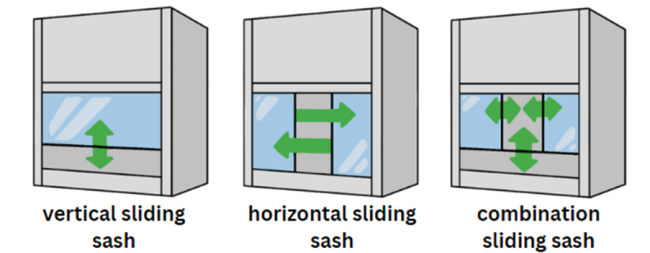Fume hoods play a critical role in research labs by ensuring the safety of personnel and the environment. Fume hoods work by pulling air away from the user to the back of the hood. The fume hood then filters and vents the air outdoors. Fume hoods are also a major source of energy consumption for lab spaces.
Fume Hoods
Fume Hood Basics
Understanding how fume hoods operate can help ensure that they are used properly! While the goal of all fume hoods is properly ventilating the lab, there are multiple types of fume hoods that you may encounter in a lab space. The most common ones are below.
On fume hoods with combination sashes, the sash should only be opened in one direction at a time. Additionally, working with the sash as low as possible allows for the best results. Most fume hoods will indicate along the side of the sash the maximum allowable working height where the fume hood can properly operate.
Even when the fume hood is closed, it is still on! Even when the sash is shut, an air foil allows the fume hood to continue to pull air from its surroundings and vent any potentially dangerous fumes out of the lab.
When it comes to the amount of air that a fume hood pulls from the surroundings, there are two main types: Constant Air Volume (CAV) and Variable Air Volume (VAV) fume hoods. In CAV fume hoods the volume of air flowing through the hood is constant independent of the sash height. Alternatively, in VAV fume hoods, the amount of air that flows through the fume hood is adjusted depending on the sash height to maintain a proper face velocity. Therefore, when a fume hood is closed it is most effective at protecting lab users and the most energy efficient.
Fume Hood Best Practices
The best practices outlined below an help ensure the safety of lab users and improve energy efficiency.
Shut the Sash
Keeping the fume hood sash closed as much as possible when not in use maintains proper containment and airflow.
Keep the Sash Low
Following the guidelines on the fume hood for the maximum allowable working sash height not only ensures your safety but allows for efficient airflow, minimizing energy usage.
Avoid In-hood storage
Storing large items in the hood can obstruct the air flow, interfering with proper ventilation and containment. If items must be stored in the fume hood, it is best to keep them elevated to allow for air flow.
Monitor Airflow
Some fume hoods have sensors and alarms installed that monitor the airflow. It is important to be conscious of the features and attentive for any alarms for dangerous low air flow.



